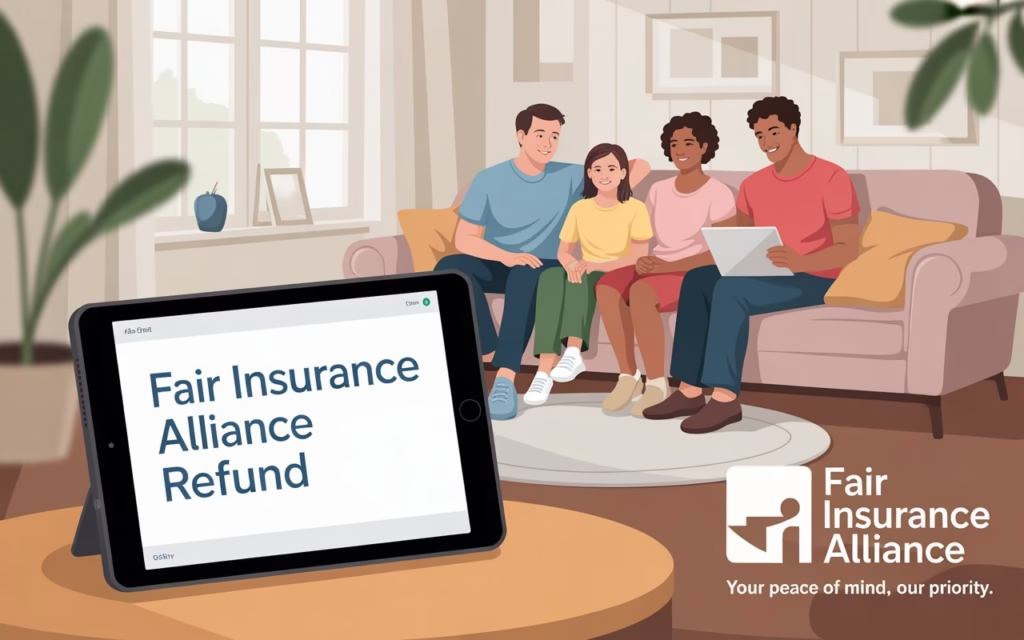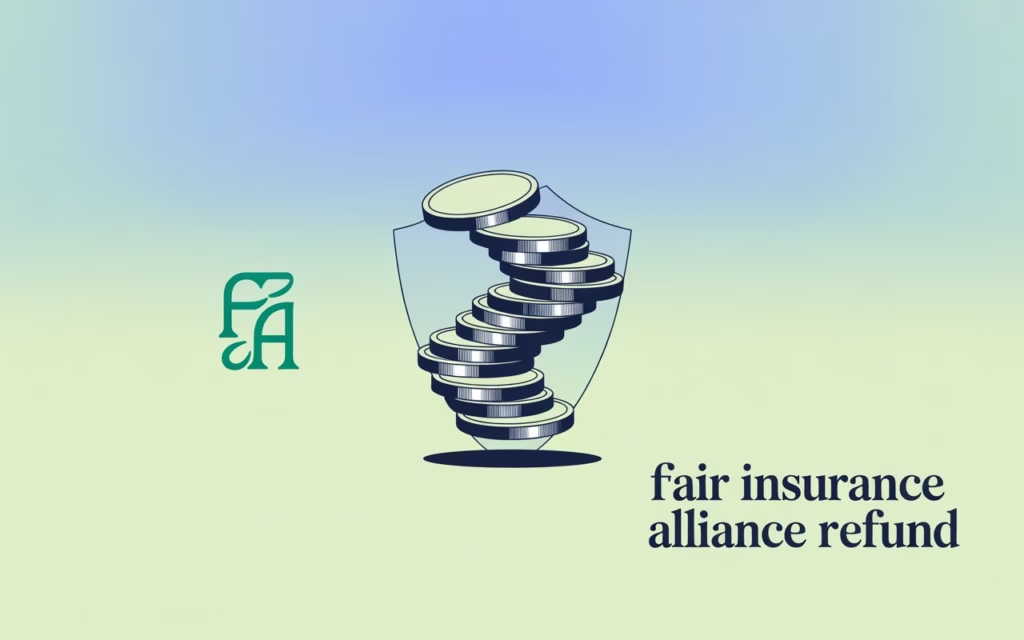What is the Fair Insurance Alliance Refund Form?
Navigating the Fair Insurance Alliance Refund process can feel overwhelming, but understanding it is crucial for any policyholder in the USA. This refund allows customers to recover money from overpayment reimbursements, billing discrepancies, or policy cancellation refunds. By using the official refund request form, policyholders can ensure that their claims are evaluated accurately and processed efficiently.
Following the correct procedures and providing all necessary refund documentation requirements can prevent delays and make the experience smooth and hassle-free. Whether you’re correcting a duplicate payment or requesting a prorated refund, knowing how to handle your insurance refund process properly ensures your money is returned promptly.
Understanding the Fair Insurance Alliance Program
The Fair Insurance Alliance Program was created to protect consumers and maintain transparency in insurance transactions. It ensures that any overpayment reimbursement or policy cancellation refund requests are handled fairly and efficiently. The program offers resources and guidance to help policyholders understand the refund eligibility criteria and supports them through the refund form submission process. It is a cornerstone of consumer protection in the U.S. insurance system.
Insurance companies participating in the alliance must follow strict insurance provider refund policies. This includes honoring requests for billing discrepancies and duplicate insurance payments. The program provides customer service support to help policyholders navigate complex refund scenarios. By participating, policyholders can feel confident that their refund requests will be evaluated transparently and processed within the recommended refund processing time.

Who Can Apply for a Refund?
Understanding who is eligible for a refund is crucial before starting the process. Individuals may qualify for a refund if they have made overpayments, cancelled a policy early, or noticed billing discrepancies. Duplicate payments are another common reason for refund requests. The key is meeting the refund eligibility criteria set by the insurance provider.
Eligibility also considers specific policy terms. For instance, a policyholder requesting a policy cancellation refund must prove the cancellation date and payment history. Those with duplicate insurance payments must provide evidence of repeated transactions. Following these rules ensures a faster and more reliable insurance refund process.
Required Documents Before Applying
Before filing a refund, gathering all necessary refund documentation requirements is critical. Policyholders should prepare documents such as payment receipts, bank statements, policy contracts, and cancellation notices. Accurate documentation supports a policyholder refund request and helps prevent delays. Attach supporting documents when submitting your form to avoid unnecessary follow-ups.
Having complete paperwork also makes the refund form submission process smoother. It demonstrates compliance with the insurance provider refund policy. Missing documents can result in delayed approvals or outright denial. Keep copies of all paperwork for reference, as you may need them for tracking or dispute resolution.

Step-by-Step Process to Apply for a Refund
Step 1 – Obtain the Refund Form
To begin, you must obtain the refund form from the Fair Insurance Alliance’s official website or request it from customer service support. Having the correct form ensures the process starts without errors.
Step 2 – Fill Out the Form Correctly
It is essential to provide accurate details including personal information, policy number, and payment history. Clear explanations for your refund claim, such as overpayment reimbursement or policy cancellation refund, improve approval chances.
Step 3 – Attach Supporting Documents
You must attach supporting documents like receipts, bank statements, or cancellation letters. Proper attachments validate your claim and align with the refund documentation requirements.
Step 4 – Submit the Form
Once complete, submit the refund form via online portal, email, or mail. Timely submission is vital to follow the insurance refund process and avoid delays.
Step 5 – Follow Up on Your Request
After submission, track your refund status regularly. Confirm receipt by checking your email for confirmation and contact support if needed. This ensures your policyholder refund request is processed smoothly.
Processing Time and Refund Methods
Refunds are typically processed within 10 to 30 business days, depending on the complexity of your claim. The processing time may vary due to verification, documentation review, or policy evaluation. Insurance companies often communicate expected timelines in their insurance provider refund policy.
Refunds are issued via multiple refund methods and payment options. Common methods include bank transfer refund, credit card refund, checks, or account credits. For example, a bank transfer may complete within 3–5 business days, while mailed checks can take 7–14 days. Understanding these methods ensures you know when to expect your overpayment reimbursement.
| Refund Method | Expected Processing Time | Notes |
| Bank Transfer Refund | 3–5 business days | Fastest option |
| Credit Card Refund | 5–7 business days | Refund appears on the next statement |
| Check Refund Process | 7–14 business days | Mailed to your registered address |
| Account Credit | 1–3 business days | Instantly applied to your account |
Common Mistakes to Avoid in the Refund Application
Many policyholders make errors that slow down the insurance refund process. Common mistakes include incomplete forms, missing refund documentation requirements, and incorrect payment details. Ensuring that you provide accurate details and attach supporting documents helps avoid delays.
Submitting duplicate forms or failing to comply with the insurance provider refund policy can also lead to denials. Double-checking your form and documentation is essential. Always follow the correct procedure to maintain eligibility for your policyholder refund request.

How to Check Your Refund Status
Once the form is submitted, you can track your refund status using the insurance provider’s online portal or by contacting customer service support. This allows you to monitor progress and confirm that your claim is being processed properly. Always check your email for confirmation after submission.
Monitoring the status ensures that any issues, such as missing documents or verification errors, are addressed promptly. By following these steps, you maintain a smooth refund process and avoid unnecessary delays in receiving your overpayment reimbursement.
What to Do If Your Refund Is Delayed or Denied
Sometimes, a refund may be delayed or denied due to missing documents, incorrect form completion, or policy restrictions. In such cases, it is essential to contact customer service for assistance and provide additional proof if necessary. You can appeal or reapply following the structured way for customers to reclaim their money.
Documenting all communications and keeping records of your policyholder refund request increases the likelihood of successful resolution. Being proactive helps prevent prolonged delays and ensures that refunds are typically processed within 10 to 30 business days once issues are resolved.
Tips for a Smooth and Successful Refund Process
A smooth refund process requires careful preparation and attention to detail. Always avoid delays by double-checking your form and ensure all refund documentation requirements are included. Timely follow-ups with customer service support can accelerate processing.
Keeping organized records of all submissions, including refund confirmation emails, supports accountability and prevents disputes. By taking these precautions, your policyholder refund request can be completed efficiently, minimizing stress and maximizing chances for overpayment reimbursement.
FAQs of Fair Insurance Alliance Refund
1. Is Fair Insurance Alliance real?
It’s unclear—research carefully or check reviews and official sources to verify legitimacy.
2. How do I get a refund on my insurance premiums?
Contact your insurer; refunds depend on policy terms and how much coverage you’ve used.
3. Is the car insurance refund real?
Yes, but only in certain cases, like cancellations or overpayments.
4. Do I get a refund after cancelling car insurance?
You may get a prorated refund if you paid in advance and cancel before the policy ends.
5. Can I get a refund if I cancel my car insurance?
Yes, typically a partial refund is issued if no claims were made and coverage remains.
Final Thoughts
The Fair Insurance Alliance Refund Form provides a reliable method for American policyholders to reclaim money from insurance providers due to billing discrepancies, overpayment reimbursement, or policy cancellation refund. Following proper steps, preparing complete documentation, and staying informed ensures a smooth refund process.
Understanding the insurance refund process, using the correct refund request form, and monitoring your refund status are essential to a successful claim. By adhering to these practices and taking advantage of customer service support, you can confidently secure your policyholder refund claim without unnecessary complications.

